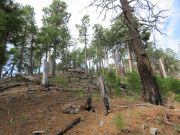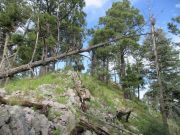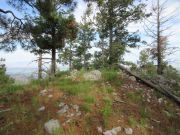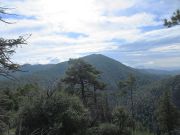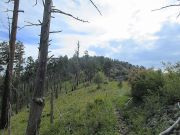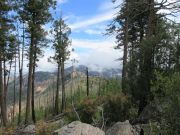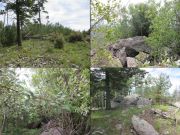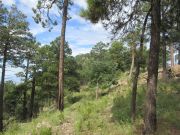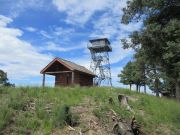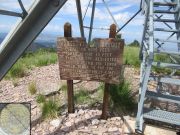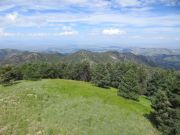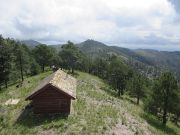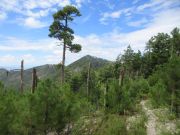
The Mountains of Arizona
www.surgent.net |
|
Johnson Peak • Raspberry Peak • Monte Vista Peak These three peaks lie along a common ridge jutting west from the main north-south ridge that includes Chiricahua Peak, the range's highest point. Good trails allow easy access onto this high ridge, with somewhat-easy access to two of the peaks that lack formal trails to their tops. This was my first summer staying in Bisbee full time. I had hoped to hike these trails and peaks early in the season, but the monsoon builds fast here in southeast Arizona and never really goes away. For most of July and August, hiking in the high Chiricahuas did not seem like a good idea. It can be warm even at 7,000 feet and higher, and I did not want to be outrunning thunderstorms the whole time. Two days ago, the weather made a sudden change for the better. The humidity lessened as did the clouds, the sky was bluer, and in Bisbee, the breezes were refreshing, not sultry. This being Labor Day weekend, I decided now was a good time to hike these peaks. I left Bisbee at 5 a.m. and followed roads into Elfrida, then US-191 to AZ-181 eastbound to where Turkey Creek Road continues east as AZ-181 curves north. I was on this road just one other time, in February 2000 when I climbed Chiricahua Peak for the first time. Turkey Creek Road is hardpack and gravel with a good tread. It narrows in some places but still wide enough for vehicles to pass. The first 8.5 miles is through private ranch properties, then passes into the Coronado National Forest, now marked as FR-41. The road is narrower and rockier in places but passable by most vehicles when dry. I drove past all the campers and parked at the end of the road at a turnaround, the trailhead for the Morse Canyon Trail (Tr-43). According to my odometer, this was 10.9 miles from the beginning of Turkey Creek Road back on AZ-181. From my home, I had driven 66 miles, and it was 6:30 a.m. now. The sun was up but I was still in the canyon shadow. The sky was clear but with low puffy clouds that moved through fast. A steady breeze was blowing, and looking up, the clouds were moving very quickly, suggesting higher winds on the crest. It was cool, about 55°. I got properly dressed and started hiking at 6:40.
Date: September 1, 2024
• Elevation: 8,890 feet
• Prominence: 330 feet
• Distance: 0.6 mile
• Gain: 330 feet
• Conditions: Breezy with fast-moving clouds
Arizona
•
Main
•
PB
•
LoJ
The Morse Trail is an excellent trail. It was wide with a good tread and always easy to see. I was expecting it would be obscured by encroaching brush, but that was never the case. In a couple place, where it crossed into and out of the main canyon drainage, there was brush, but these segments lasted for just a few yards at most.
Higher up, it makes long upward traverses and then big switchbacks which helps moderate the overall grade. It was never exposed, and deadfall was minimal. A few big trees had been uprooted and knocked over, but the trail skirted these. I made pretty good time, covering the two miles and about 2,000 feet of elevation gain in about an hour and fifteen minutes.
I was in the saddle connecting Johnson Peak to the west with Monte Vista Peak to the east. I took a ten-minute break to rest and have a drink, plus cache some water for when I returned later on. It was cooler up here and as expected, much breezier, but not so bad as to be bothersome.
I had to get around some deadfall to get onto the lower slope of Johnson Peak. The first segment is through tall pines with little undergrowth, the slope steep and covered in pine needles. I aimed for some rocks ahead with adolescent pines. From here to the top, the route followed the rocky spine of the east ridge. Barbed wires from an old fence lay on the ground the whole way.
After pushing through a couple more small clumps of trees, I was on the home stretch. The top is small with a low rock outcrop and cairn, wooded but with views. I signed into the register, the first to do so since May. The hike from the saddle to here took about 20 minutes. I did not stay long, and the hike back to the saddle took another 15 minutes.
I was happy to get this peak done. This was my first peak in Arizona hiked in almost two months. I've been hiking the stairs around Bisbee to keep my legs in shape, so they did fine. What I discovered was my ankles were out of condition. I was turning them often. I was moving a little slower than normal for terrain like this.
The time was roughly 8:30 when I arrived back at the saddle. Monte Vista Peak rose to the east, its lookout tower visible. The clouds were a mix of wispy high clouds and puffier low clouds. Looking west, there were sunny skies, while on the highest crest to the east, the peaks were completely shrouded by the clouds. Nothing looked threatening, though.
I decided I would next set a course for Raspberry Peak, then tag Monte Vista Peak as I returned for the hike out.
Elevation: 9,420 feet
• Prominence: 416 feet ✳
• Distance: 10 miles
• Time: 5 hours, 40 minutes (whole hike)
• Gain: 2,990 feet (gross)
• Conditions: Cool, sunny with clouds and a stiff breeze
PB
•
LoJ
•
Lidar
Back on the main trail, I followed it east. It is level and even drops a little bit, then starts a steady upward traverse of the west slopes of Monte Vista Peak. The grasses and flowering plants were very thick here and obscured the trail, but as long as I didn't daydream too much, I had no trouble staying on it.
The trail makes one switchback turn, then curls around the north slopes of Monte Vista, meeting up with the Crest Trail at the east base of Monte Vista Peak. I had my first views of Raspberry Peak here.
I missed a turn here and stayed high on the grassy ridge, which worked well, but then I saw the trail down and to my left, and dropped down to meet it. I was soon at the saddle between Raspberry and Monte Vista Peaks.
The trail does not go to Raspberry Peak's top. It traverses its northern slopes, so I figured I would follow it to its highest point, then bust upslope from there to the top.
That's what I did but it proved not to be the best decision. The slopes here were choked in branchy downfall and heaps of talus blocks. Combined together, it was a chore to slowly work through the tangles and manage the rocks. I never actually scrambled, nor would I call this bushwhacking. There should be a new name for this kind of rocky-branchy terrain.
I was soon on the main ridge, which opened up better. I came upon the short summit ridge. One group of rock outcrops about six feet high looked like a possible highpoint, so I scampered up these and touched the top with my toe.
The land seemed to rise a little more to the east, so I went that way, entering into thick aspen, and coming upon more large rocks. I found two that seemed to be highest, and tagged each. There was too much brush in between to sight. I did not stay long, not even looking for a register. I was here just long enough to tag some rocks and snap a couple photographs.
The clouds were billowing over the main crest, and Chiricahua Peak was completely covered over. I could see Paint Rock, an unranked peaklet on the ridge north of Raspberry Peak. The clouds were not amassing yet into anything concerning.
I walked westward off the main ridge and still encountered some rocks and branches, before meeting up with the trail again. I proceeded west about a half mile to go actually tag Monte Vista Peak.
Elevation: 9,357 feet
• Prominence: 215 feet
• Distance: 0.4 mile
• Gain: 215 feet
• Conditions: Sunnier but still breezy
PB
•
LoJ
•
USGS BM Datasheet
I followed the trail back to the base of Monte Vista Peak, and saw a group above me, five of them. They were already on their way up to the peak, so I got in behind them, and slightly surprised them when I appeared as they weren't expecting to see anyone.
Monte Vista Peak hosts a 40-foot tall lookout tower and a hut, plus a couple out-buildings. The forest has been cleared here and the open area to the west of the summit has been used in the past as a helicopter pad. The big forest fires from the past twenty years seemed to spare the immediate area. There were some burned trees but most looked healthy.
I hung back while this group took their photos and climbed the tower. It was not manned today, so getting onto the top wasn't possible as the hatch was locked. When they were mostly down, I walked up and shot a couple photos, taking advantage of the elevated perch for some fine views.
The clouds were still doing their thing and the wind was steady but not strong, gusts about 20 miles per hour at most. It was still cool but pleasant, in the 60s. The group were very friendly, and I sat with them on the stoop of the hut where we all had a rest.
They seemed like a strong knowledgeable group. They were planning a big circuit to include Chiricahua Peak, then descend a trail from there back down. Me, I was essentially done, just needing now to return to my car. The break at the hut stretched to almost twenty minutes and I could have easily stayed there another hour. It was peaceful and relaxing, and my muscles were turning into jelly the more I sat.
They soon got on their way, and so did I. I wished them luck and appreciated their company. I was looking at a shade over three miles back to my car. It was a little before 11 a.m. now.
The outbound hike went very well. The fine trail made it easy for me to keep up a good pace almost the whole way down. I stopped back at the saddle below Johnson Peak and recovered my water, taking a break here.
The 2,000-foot drop down Morse Canyon went efficiently. I didn't have to worry too much about random rocks slowing me down. I fast-walked much of it, and was back to my car at 12:25 p.m.. I covered about 11 miles total including the two side hikes, with almost 3,500 feet of total elevation gain. I hadn't done a long hike like this since May and could feel the fatigue.
I changed into more comfortable clothes for the drive out. On the stretch of Turkey Creek Road that lies on the private lands, I saw a sign for the Johnny Ringo gravesite. It's on private land and access is sometimes open, but not today. Next time I'm up here, I'll check it out. Ringo was one of the bad guys loosely associated with the cattle rustlers and other ne'er-do-wells of the Tombstone era. He was not part of the 1881 shootout at the OK Corral, but he was in the area, and died by suicide the following year at this very spot. History has a way of romanticizing these guys, but Ringo was not a good person, famous mainly because he happened to be a peripheral character in the Earp/Tombstone saga.
Back on the main highway (US-191), the clouds had built into storms, which was sudden because everything was sunny as of when I exited the canyon. I hope the group I met got to their peak and got down before things became too nasty. I was back in Bisbee by 2 p.m..
|
|
